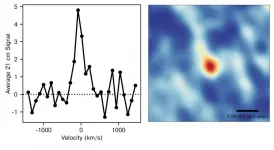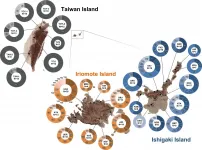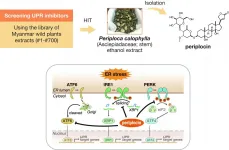Measuring gene expression changes over time may help predict T1D diabetes progression
An international research team, including the University of South Florida Health Informatics Institute, created and validated a predictive model with potential for early monitoring of infants at risk for type 1 diabetes
2021-06-07
(Press-News.org) TAMPA, Fla. (June 4, 2021) — Type 1 diabetes (T1D) is an autoimmune disease in which a misdirected immune system gradually destroys healthy pancreatic islet β cells, resulting in a lack of insulin. The exact cause of T1D remains unknown. However, β cell-reactive autoantibodies can be detected in circulating blood months to years before diagnosis, raising the possibility of intervening to stop or delay T1D before children develop the disease.
Monitoring the number, type, and concentration of autoantibodies appearing in the blood can help predict the long-term risk of progression from autoimmunity to symptomatic T1D.
Now new findings suggest that measuring how patterns of gene expression in white blood cells change in children starting in infancy - before autoantibodies appear indicating an autoimmune reaction against the β cells - can predict earlier and more robustly which genetically-susceptible individuals will progress to T1D. The comprehensive international study included co-investigators from the University of South Florida Health Informatics Institute (HII).
The research was published on March 31 in Science Translational Medicine.
HII Director Jeffrey Krischer, PhD, a professor in the USF Health Morsani College of Medicine's Department of Internal Medicine, and Hemang M. Parikh, PhD, an assistant professor of bioinformatics in the USF Health Morsani College of Medicine's Department of Pediatrics, were co-investigators of the study led by the UK researchers at the University of Cambridge.
"Our identification of specific changes in the blood related to natural killer cells provides evidence for the potential involvement of these immune cells in the onset or progression of type 1 diabetes in asymptomatic children," Dr. Parikh said. "This creates a possible new target for early therapeutic intervention using immune modulation."
This study was based on blood samples longitudinally collected from 400 children in The Environmental Determinants of Diabetes in the Young (TEDDY) consortium as they grew older, from birth to age 6. (TEDDY follows children at risk of developing T1D, collecting blood and other samples long before disease symptoms emerge.)
Using genomic approaches and bioinformatics analytical methods, the blood samples were processed to measure the expression of thousands of genes simultaneously. This allowed researchers to identify which genes were switched on and off in each child at varying points in time.
Among the study's key findings:
Discovered dynamic, early changes in white blood cell gene expression: Whether or not they progressed to autoimmunity or T1D as they matured, all children in the study showed marked changes in patterns of gene expression in their blood within the first few years of life. This observation highlights the dynamic context in which healthy infants develop early autoimmune disease.When the researchers adjusted for the large changes in gene expression patterns with age, very specific patterns correlating with the rate of progression toward T1D diagnosis became apparent. They identified changes in blood gene expression not seen in healthy children, and these changes began before any other evidence of autoimmunity. Furthermore, the faster the changes occurred, the quicker the children progressed toward T1D onset.
Linked NK cell signature with T1D progression: By comparing a specific pattern of gene expression associated with T1D progression to groups of genes expressed by many different cell types, the researchers found that this pattern came from a distinct immune cell population known as natural killer (NK) cells. Although NK cells have been observed in the pancreas of children with recent-onset T1D, the role of these immune cells does not figure prominently in current theories explaining how the immunopathology of T1D develops. A more detailed study is needed to determine whether NK cells actively contribute to the T1D-related autoimmune process destroying β-cells in the pancreas, reflecting a pathophysiological response.
Created a robust predictive model, independently confirmed: The researchers used their new knowledge about longitudinal changes in gene expression patterns to build a model to predict which infants would get T1D and when disease onset was likely to happen. The predictive model incorporates the latest evidence about how the seroconversion of autoantibodies influences progression to T1D. Its accuracy was validated using a second, independent group of prediabetic children from the Type 1 Diabetes Prediction and Prevention Study.
"This type of large-scale research is only possible through the collaboration of many people, including healthy children at risk for T1D, patients with T1D, their families, and countless others," Dr. Parikh added. "USF is fortunate to play a part in such huge international efforts to tackle this complex autoimmune disease."
INFORMATION:
The work was supported by multiple grants from the National Institutes of Health. USF Health's Dr. Krischer leads the coordinating center for the NIH-funded TEDDY consortium.
USF Health's mission is to envision and implement the future of health. It is the partnership of the USF Health Morsani College of Medicine, the College of Nursing, the College of Public Health, the Taneja College of Pharmacy, the School of Physical Therapy and Rehabilitation Sciences, the Biomedical
Sciences Graduate and Postdoctoral Programs, and USF Health's multispecialty physicians group. The University of South Florida is a high-impact global research university dedicated to student success. Over the past 10 years, no other public university in the country has risen faster in U.S. News & World Report's national university rankings than USF. For more information, visit health.usf.edu
ELSE PRESS RELEASES FROM THIS DATE:
2021-06-07
A research team from the University of Copenhagen and University of Helsinki demonstrates it is possible to predict individual preferences based on how a person's brain responses match up to others. This could potentially be used to provide individually-tailored media content -- and perhaps even to enlighten us about ourselves.
We have become accustomed to online algorithms trying to guess our preferences for everything from movies and music to news and shopping. This is based not only on what we have searched for, looked at, or listened to, but also on how these activities compare to others. Collaborative filtering, as the technique is called, uses hidden ...
2021-06-07
A team of astronomers from the National Centre for Radio Astrophysics (NCRA-TIFR) in Pune, and the Raman Research Institute (RRI), in Bangalore, has used the Giant Metrewave Radio Telescope (GMRT) to measure the atomic hydrogen gas content of galaxies 9 billion years ago, in the young universe. This is the earliest epoch in the universe for which there is a measurement of the atomic hydrogen content of galaxies. The new result is a crucial confirmation of the group's earlier result, where they had measured the atomic hydrogen content of galaxies 8 billion years ago, and pushes our understanding of galaxies to even earlier in the universe. ...
2021-06-07
Decades of research has revealed the remarkable morphological adaptations of sea snakes to aquatic life, which include paddle-shaped tails, salt-excreting glands, and the ability to breathe through their skin.
In a new study published in Biological Journal of the Linnean Society, researchers at the University of Adelaide detail the enlarged touch receptors that evolved in male turtle-headed sea snakes (Emydocephalus annulatus), to help them locate and court females in aquatic environments.
Lead author, Jenna Crowe-Riddell, PhD graduate at the University of Adelaide's School of Biological Sciences, says on land, snakes use tongue-flicking ...
2021-06-07
Older people need digital skills training to learn to use digital technology more independently, but they also seek digital training opportunities because of the social benefits they offer, according to a recent study from the University of Eastern Finland. Published in International Journal of Lifelong Education, the study examined perceived benefits of digital skills training among older adult learners, their teachers and peer tutors. Data for the study were collected in liberal adult education organisations, such as community colleges, as well as in peer tutoring sessions organised by third sector actors.
New skills and friendships
The coronavirus pandemic has, for its part, highlighted inequalities in the availability and ...
2021-06-07
The Amami, Okinawa region of Japan may be designated a World Heritage Site in July of 2021 based on the recent recommendation from the IUCN. The Iriomote wild cat is a symbolic species of the region, having evolved independently on the island. The area is home to many other highly endemic and unique evolutionary species. A research group comprised mostly of former students of Professor Koji Tojo's Faculty of Science lab of Shinshu University focused on the study of dragonflies, continuing from their previous study of their comparative embryogenesis. About 5,000 species of insects belonging to 26 families of the order Dragonfly are known ...
2021-06-07
A long-standing basic question in biology relates to how life satisfies the fundamental constraints put on it by physics and chemistry. Darwin's warm pond hypothesis for the origin of primordial cells is a familiar one. Advances have been made in mapping out the organic molecules that likely existed on the early Earth, and recently candidate prototypic pathways in early cells have been formulated. But how did these candidates' early biochemistry actually function as a system, on which subsequent cellular life is based?
A team of bioengineers at the Novo Nordisk Foundation Center for Biosustainability, DTU, has now defined ten overarching classes of constraints on early metabolic ...
2021-06-07
A minimally-invasive procedure that targets the nerves near the kidney has been found to significantly reduce blood pressure in hypertension patients, according to the results of a global multicentre clinical trial led in the UK by researchers at Queen Mary University of London and Barts Health NHS Trust.
The study, published in The Lancet and presented at the American College of Cardiology meeting, suggests that the procedure could offer hope to patients with high blood pressure who do not respond to recommended treatments (resistant hypertension), and are at greatly increased risk of cardiovascular diseases, including stroke and heart attack.
The international clinical trial tested a one-hour procedure called 'renal denervation', which uses ultrasound energy to ...
2021-06-07
The fluorescence dyes were dominant species of the near-infrared (NIR) dyes, but the energy gap of the NIR dyes between S1 state and S0 state is generally small to induce the ultrafast internal conversion dynamics to quench the NIR emission of the fluorescence dyes. Therefore, the quantum yield of the fluorescence NIR dyes is usually low. On the other hand, the organic dyes with room-temperature phosphorescence (RTP) in the NIR region could prevent the ultrafast internal conversion dynamics quenching because of the T1 state and S0 state the organic molecules are spin forbidden.
Recently, scientists in China reported a new assumption to construct ...
2021-06-07
The Spanish Foundation for Science and Technology (FECYT) has presented this week at the headquarters of the National Science and Technology Museum in Madrid the main results of the 10th Social Perception of Science Survey carried out in 2020.
The presentation was attended by Pedro Duque, Minister of Science and Innovation, Josep Lobera, Professor of Sociology at the Autonomous University of Madrid (UAM) and scientific co-director of the Survey and the subsequent study, and Rosa Capeáns, Director of the Scientific Culture and Innovation Department of FECYT. Pampa García, Editor-in-Chief of the SINC Agency, moderated a debate in which the results were presented in six blocks: Interest in ...
2021-06-07
In the present study, Dr. Hidetoshi Hayashi (Professor, Nagoya City University) and collaborators screened small-molecule compounds that suppress UPR, using Myanmar wild plant extracts library. The screening system to track X-box binding protein 1 (XBP1) splicing activity revealed that the ethanol extract of the Periploca calophylla stem inhibited the inositol-requiring enzyme 1 (IRE1)-XBP1 pathway. They isolated and identified periplocin as a potent inhibitor of the IRE1-XBP1 axis. Periplocin also suppressed other UPR axes, protein kinase R-like endoplasmic reticulum kinase (PERK), and activating transcription ...
LAST 30 PRESS RELEASES:
[Press-News.org] Measuring gene expression changes over time may help predict T1D diabetes progression
An international research team, including the University of South Florida Health Informatics Institute, created and validated a predictive model with potential for early monitoring of infants at risk for type 1 diabetes





